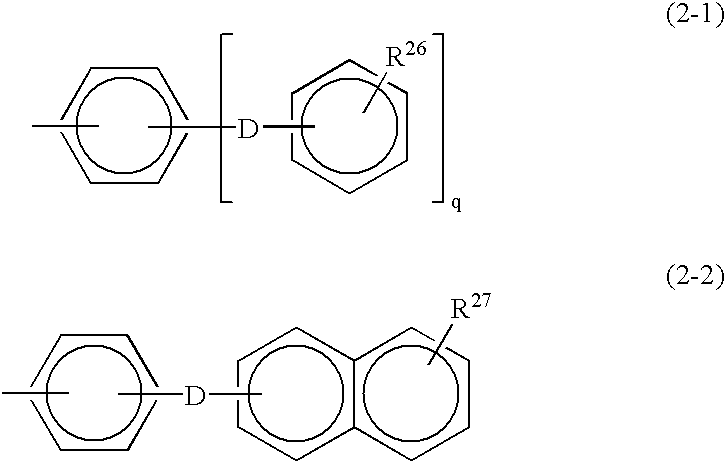Monomer containing electron-withdrawing group and electron-donative group, and copolymer and proton-conductive membrane comprising same
a proton-conductive membrane and electron-withdrawing group technology, applied in the preparation of carbonyl compounds, non-metal conductors, organic chemistry, etc., can solve the problems of insufficient inorganic compounds, insufficient adhesion of organic polymers to electrodes, and inability to replace such aqueous soluble-form electrolytes with solid electrolytes
- Summary
- Abstract
- Description
- Claims
- Application Information
AI Technical Summary
Benefits of technology
Problems solved by technology
Method used
Image
Examples
example 1
[0132] 131.86 g (303 mmols) of 2,5-dichloro-4'-(4-phenoxyphenoxy) benzophenone obtained in the Synthesis Example, 90.69g (190 mmols) of 4,4'-bis(4-chlorobenzoylamino)diphenyl ether, 7.4 g (49 mmols) of sodium iodide, 7.4 g (11 mmols) of bistriphenylphosphine nickel dichloride, 29.8 g (113 mmols) of triphenyl phosphine and 494.4 g (760 mmols) of zinc were measured out in a three-necked flask equipped with a reflux condenser and a three-way cock. The flask was then dipped in a 70.degree. C. oil bath. The air in the flask was then replaced by nitrogen. To the content of the flask was then added 1,000 ml of N-methyl-2-pyrrolidone in a nitrogen atmosphere to initiate polymerization reaction. After 20 hours of reaction, the reaction solution was then diluted with 500 ml of N-methyl-2-pyrrolidone. The polymerization solution was then poured into a drastically excess 1:10 mixture of hydrochloric acid and methanol to cause the precipitation of a polymer. The polymer thus precipitated was rep...
example 2
[0134] The reaction procedure of Example 1 was followed except that the formulation of the monomers to be charged comprised 105.49 g (242 mmols) of 2,5-chloro-4'-(4-phenoxyphenoxy) benzophenone and 108.83 g (228 mmols) of 4,4'-bis(4-chlorobenzoylamino)diphenyl ether. As a result, a polymer was obtained in an amount of 170.1 g (yield: 94%). The polymer thus obtained had a weight average molecular weight of 144,000.
[0135] 150 g of the polymer thus obtained was then subjected to sulfonation in the same manner as in Example 1 to obtain 178.4 g of a sulfonated polymer.
example 3
[0136] The reaction procedure of Example 2 was followed except that 108.83 g (228 mmols) of 4,4'-bis(4-chlorobenzoylamino) diphenyl ether was replaced by 108.83 g (228 mmols) of 3,4'-bis(4-chlorobenzoylamino)dipheny-l ether. As a result, a polymer was obtained in an amount of 170.1 g (yield: 94%). The polymer thus obtained had a weight average molecular weight of 123,000.
[0137] 150 g of the polymer thus obtained was then subjected to sulfonation in the same manner as in Example 1 to obtain 164.4 g of a sulfonated polymer.
PUM
| Property | Measurement | Unit |
|---|---|---|
| temperatures | aaaaa | aaaaa |
| temperature | aaaaa | aaaaa |
| mol % | aaaaa | aaaaa |
Abstract
Description
Claims
Application Information
 Login to View More
Login to View More - R&D
- Intellectual Property
- Life Sciences
- Materials
- Tech Scout
- Unparalleled Data Quality
- Higher Quality Content
- 60% Fewer Hallucinations
Browse by: Latest US Patents, China's latest patents, Technical Efficacy Thesaurus, Application Domain, Technology Topic, Popular Technical Reports.
© 2025 PatSnap. All rights reserved.Legal|Privacy policy|Modern Slavery Act Transparency Statement|Sitemap|About US| Contact US: help@patsnap.com



